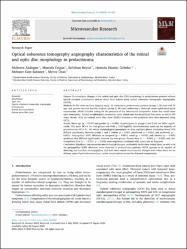Optical coherence tomography angiography characteristics of the retinal and optic disc morphology in prolactinoma

View/
Access
info:eu-repo/semantics/embargoedAccessDate
22.08.2022Author
Akdoğan, MüberraDoğan, Mustafa
Beysel, Selvihan
Gobeka, Hamidu Hamisi
Sabaner, Mehmet Cem
Oran, Merve
Metadata
Show full item recordCitation
Akdogan, M., Dogan, M., Beysel, S., Gobeka, H. H., Sabaner, M. C., & Oran, M. (2022). Optical coherence tomography angiography characteristics of the retinal and optic disc morphology in prolactinoma. Microvascular Research, 104424.Abstract
Purpose
To investigate changes in the retinal and optic disc (OD) morphology in prolactinoma patients without optical chiasmal compression and/or visual field defects using optical coherence tomography angiography (OCTA).
Methods
In this cross-sectional imaging study, 16 consecutive prolactinoma patients (group 1, 32 eyes) and 15 age- and gender-matched healthy subjects (group 2, 30 eyes) underwent a thorough neuro-ophthalmological examination, which included testing for the presence of any intracranial compressive lesion that could cause optic neuropathy. Retinal morphological parameters, outer retinal and choriocapillaris flow areas, as well as OD vessel density (VD) and retinal nerve fiber layer (RNFL) thickness in for quadrants were then measured using OCTA.
Results
Mean age (p = 0.537) and gender (p = 0.385) of participants in groups 1 and 2 did not differ significantly. The mean BCVA for both groups was 0.00 ± 0.00 logMAR. Microadenomas made up the majority of prolactinomas (87.1 %). All retinal morphological parameters in deep capillary plexus (excluding foveal VD) differed significantly between groups 1 and 2 (whole: p < 0.001, parafoveal: p = 0.021, and perifoveal: p < 0.001). Peripapillary RNFL thickness in temporal (p < 0.001), nasal (p = 0.010), and inferior (p = 0.007) quadrants also differed significantly between the two groups. Foveal deep (r = −0.304, p = 0.035) and choriocapillaris flow (r = −0.511, p = 0.008) were negatively correlated with tumor size at diagnosis.
Conclusions
Significant microvascular morphological changes, particularly in the deep retinal layer, as well as in the peripapillary RNFL thickness, were observed in prolactinoma patients. OCTA appears to be capable of detecting non-manifest circumpapillary and even intra-retinal microvascular changes even when there are no obvious signs of prolactinoma-related ocular complications caused by chiasmal compression.















